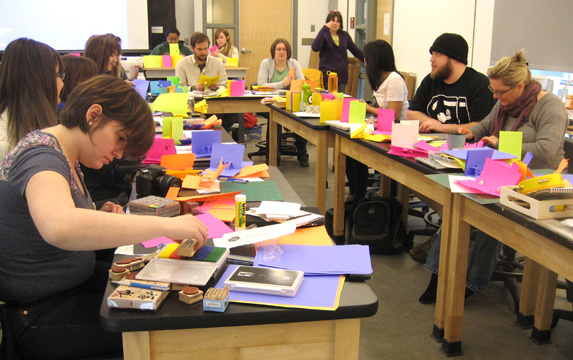Resource:How to teach faculty and students about the design and delivery of pop-up classes
Contents
Introduction
Pop-up classes are, generally speaking, short extracurricular workshops that offer students an opportunity to engage in new material, or activities not typically covered in the traditional curriculum. In pop-ups, interactivity is key: they're not about formal instruction, they're about discovery and hands-on learning. The way they're implemented varies dramatically from institution to institution, with pop-up classes taking on different formats, topics, audiences and even instructor pools.
By Who and for Who?
Who are the Instructors?
Your instructor pool could be very specific (only faculty, never faculty, only students) or could be broader and include the entire campus and off-campus community, including alumni. Broadening your instructor pool can be a great way to engage the community.
Who is Your Target Audience?
Some pop-ups are targeted only to students and in some cases a subset of students (e.g., undergraduates in particular majors). Some can be developed for other specialized audiences (segments of alumni, faculty or the community). Alternatively, you can open up a pop-up to everyone, encouraging the mixing of backgrounds. You can also leave it up to the instructor to identify the audience.
Getting Your Class Off the Ground
Should it have a topical focus or skills focus?
Consider the goals for your pop-up. Do you want to boost student skills in a particular area (e.g., a fabrication technique or communication skills) or discipline (e.g., literature)? Or do you want to offer an interdisciplinary pop-up that utilizes instructors with different backgrounds and fosters interactions among students from different majors? Your pop-up could be more about personal development, with a focus on mindsets and attitudes. You may just decide to leave it up to the instructor(s) and supply and demand.
How Do I Pick a Topic?
Your topic should cater to your audience, allowing them to branch out of their usual studies. For example, you might teach a group of business students about basic graphic design principles.
Pick a topic that facilitates the learning you want to take place. For example, if your goal is to give students exposure to basic scientific principles, then a great pop-up class would allow students hands-on interactions with buoyant objects. Let them make tin foil boats and see who can best demonstrate their understanding of buoyancy by awarding a small prize to the boat which holds the most nickels. This accomplishes your goal of teaching a topic, allowing students to explore it, and giving them hands-on experience while keeping them interested. Students coming away from your pop-up class with a positive mindset of what they have been exposed to will encourage them to investigate more on their own.
Additionally, keeping your audience in mind, the difficulty of material and assignments should be within the grasp of the group. Don't attempt to teach 5th graders multivariable calculus and don't attempt to teach engineering grad students about buoyancy with tin foil boats. They may have fun, but the goal is for people to learn something new.
What is the best place to conduct a pop-up class?
It would be better if you choose a peaceful room, you may actually ask the school/ college management members to arrange a room for you, but if that isn't possible it is better that you rent a room of low cost to conduct the class so that it doesn't become a burden on you.
The Pitch of an Idea
Should your pop-ups be funded or self-funded?
To run pop-ups, it's useful to have some minimal budget for basic materials, food, etc. This funding could come from many sources: the university, the department, or student registration fees. If funded from student registration fees, your pop-ups can be (mostly) self-funded and a stand-alone entity within the university. This approach can also help with accountability of the students. By not charging, however, you can broaden student participation and those attending will be there because of personal interest and passion, not simply because they paid. What are the basic requirements to conduct a pop-up class?
Advantages of pop-up classes:
- Flexible Hours
- Easy to Jump into
- Not a Big Commitment (Even Busy People can do it)
- A Quick Way to Learn or Practice Something
- Can be Tailored to Accommodate Wide Ranges of People or Specific Groups
- Relaxed Atmosphere
- Easy to Set Up
- Easy to Run
- Can be Cheap (To Organize/Run)
- A Chance to Fail with Nothing to Lose
Differentiating Your College's Pop-Up
Offer credit as an option
If credit is attached to a pop-up it can offer students an alternative way fulfills part of a degree or certificate program. However, self-determination theory (and experience) indicates that rewards like credit can demotivate students, so non-credit can be considered, too. You'll likely attract different students with credit versus non-credit pop-ups.